 W
WThis is a list of the mammal species recorded in Bhutan. There are ninety mammal species in Bhutan, of which one is critically endangered, ten are endangered, fourteen are vulnerable, and three are near threatened.
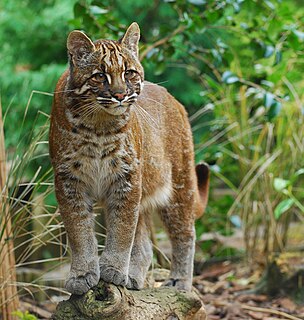 W
WThe Asian golden cat is a medium-sized wild cat native to the northeastern Indian subcontinent, Southeast Asia, and southern China. It has been listed as Near Threatened on the IUCN Red List since 2008, and is threatened by hunting pressure and habitat loss, since Southeast Asian forests are undergoing the world's fastest regional deforestation.
 W
WThe Asian gray shrew is a species of mammal in the family Soricidae. It is found in Bhutan, Cambodia, China, India, Laos, Malaysia, Myanmar, Nepal, Pakistan, the Philippines, Thailand, and Vietnam. It is one of the commonest species within its range and the International Union for Conservation of Nature has assessed its conservation status as being of "least concern".
 W
WThe Indian pipistrelle is a species of bat in the family Vespertilionidae found in Afghanistan, Bangladesh, Bhutan, Cambodia, India, Myanmar, Nepal, Pakistan, Sri Lanka, Thailand, and Vietnam.
 W
WThe intermediate horseshoe bat is a bat species of the family Rhinolophidae that is very widespread throughout much of the Indian subcontinent, southern and central China and Southeast Asia.
 W
WThe wrinkle-lipped free-tailed bat is a species of bat in the family Molossidae. It is found in Bangladesh, Bhutan, Cambodia, China, Cocos (Keeling) Islands, India, Indonesia, Laos, Malaysia, Myanmar, Nepal, the Philippines, Sri Lanka, Thailand and Vietnam.
 W
WThe Himalayan brown bear, also known as the Himalayan red bear, isabelline bear or Dzu-Teh, is a subspecies of the brown bear and is known from northern Afghanistan, northern Pakistan, northern India, west China and Nepal. It is the largest mammal in the region, males reaching up to 2.2 m (7 ft) long while females are a little smaller. These bears are omnivorous and hibernate in a den during the winter. While the brown bear as a species is classified as Least Concern by the IUCN, this subspecies is highly endangered and populations are dwindling. It is Endangered in the Himalayas and Critically Endangered in Hindu Kush.
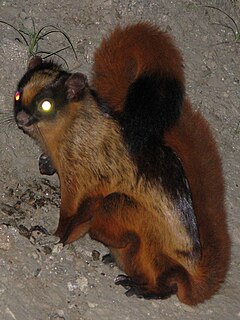 W
WThe Bhutan giant flying squirrel, also known as the gray's giant flying squirrel or noble giant flying squirrel, is a species of rodent in the family Sciuridae. This species lives in Himalayan forests and it is one of the largest flying squirrels. Like other flying squirrels, it is mainly nocturnal and able to glide long distances between trees by spreading out its patagium, skin between its limbs.
 W
WThe big-eared horseshoe bat is a bat species within the Rhinolophidae native to China, India, Indonesia, Laos, Malaysia, Nepal, Pakistan, the Philippines, Thailand, and Vietnam.
 W
WThe binturong, also known as bearcat, is a viverrid native to South and Southeast Asia. It is uncommon in much of its range, and has been assessed as Vulnerable on the IUCN Red List because of a declining population trend that is estimated at more than 30% since the mid 1980s.
 W
WThe black giant squirrel or Malayan giant squirrel is a large tree squirrel in the genus Ratufa native to the Indomalayan zootope. It is found in forests from northern Bangladesh, northeast India, eastern Nepal, Bhutan, southern China, Myanmar, Laos, Thailand, Malaysia, Cambodia, Vietnam, and western Indonesia.
 W
WThe black musk deer or dusky musk deer is a species of even-toed ungulate in the family Moschidae. It is found in Bhutan, China, India, Myanmar, and Nepal.
 W
WThe Forrest's pika is a species of mammal in the pika family, Ochotonidae. It is found in Bhutan, China, India, and Myanmar. The summer dorsal pelage and ventral pelage are dark rufous or blackish brown, and the winter dorsal pelage is a grayish brown, slightly lighter in tone than the ventral pelage. It is a generalist herbivore. It was assessed by the IUCN Red List of Endangered Species as insufficiently known in 1994, as near threatened in 1996, and re-assessed in 2008 as a species of least concern.
 W
WThe Tibetan fox, also known as Tibetan sand fox, is a species of true fox endemic to the high Tibetan Plateau, Ladakh plateau, Nepal, China, Sikkim, and Bhutan, up to altitudes of about 5,300 m (17,400 ft). It is listed as Least Concern in the IUCN Red List, on account of its widespread range in the Tibetan Plateau's steppes and semi-deserts.
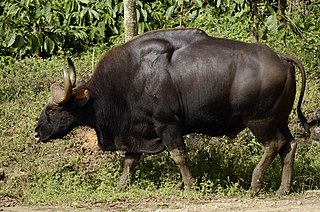 W
WThe gaur, also known as Indian bison, is native to South and Southeast Asia and has been listed as Vulnerable on the IUCN Red List since 1986. The global population has been estimated at maximum 21,000 mature individuals by 2016. It declined by more than 70% during the last three generations, and is extinct in Sri Lanka and probably also in Bangladesh. Populations in well-protected areas are stable and increasing.
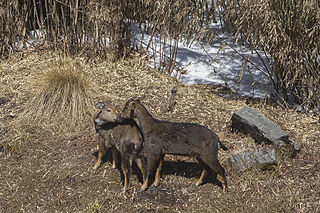 W
WThe Himalayan goral is a bovid species found across the Himalayas. It is listed as Near Threatened on the IUCN Red List because the population is thought to be declining significantly due to habitat loss and hunting for meat.
 W
WThe greater horseshoe bat is an insectivorous bat of the genus Rhinolophus. Its distribution covers Europe, Northern Africa, Central Asia and Eastern Asia. It is the largest of the horseshoe bats in Europe and is thus easily distinguished from other species. The species is sedentary, typically travelling up to 30 kilometres (19 mi) between the winter and summer roosts, with the longest recorded movement being 180 km (110 mi). The frequencies used by this bat species for echolocation lie between 69–83 kHz, have most energy at 81 kHz and have an average duration of 37.4 ms.
 W
WThe hairy-footed flying squirrel is a flying squirrel found in the mountains of the eastern Himalaya, Southeast Asia, southern China, and the island of Taiwan. It lives at elevations of 800–2,400 m (2,600–7,900 ft) above sea level.
 W
WThe Himalayan field rat, sometimes known as the white-footed Indo-Chinese rat, is a species of rodent in the family Muridae. It has a wide range, being found in India, Bangladesh, Nepal, Bhutan, China, Myanmar, Laos, Thailand, and Vietnam, with introduced populations in Indonesia (widely), Palau, and the Philippines. A common species, the International Union for Conservation of Nature has assessed its conservation status as being of "least concern".
 W
WThe Himalayan marmot is a marmot species that inhabits alpine grasslands throughout the Himalayas and on the Tibetan Plateau. It is IUCN Red Listed as Least Concern because of its wide range and possibly large population.
 W
WThe Himalayan mole is a species of mammal in the family Talpidae.
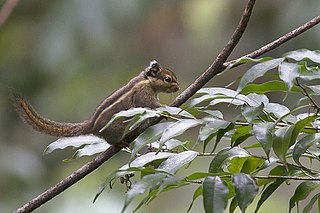 W
WThe Himalayan striped squirrel, also known as western striped squirrel, or Burmese striped squirrel, is a species of rodent in the family Sciuridae. It lives in a variety of forest from tropical to subtropical in Bhutan, Cambodia, China, India, Laos, Malaysia, Myanmar, Nepal, Thailand, and Vietnam. This species is diurnal, arboreal and feeds on fruits, vegetable matter, and insects. It often seen in small groups and uses tree holes for shelter.
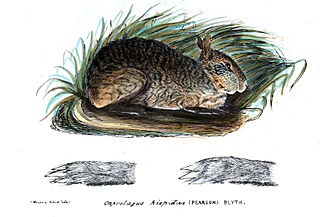 W
WThe hispid hare, also called Assam rabbit and bristly rabbit, is a leporid native to South Asia, whose historic range extended along the southern foothills of the Himalayas. Today, its habitat is highly fragmented with an area of occupancy estimated at less than 500 km2 (190 sq mi) extending over an area of 5,000 to 20,000 km2. Populations experienced a continuing decline in suitable habitat due to increasing agriculture, flood control, and human development. It is therefore listed as Endangered on the IUCN Red List since 1986. |
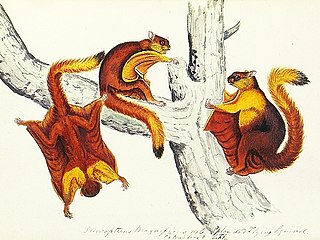 W
WHodgson's giant flying squirrel is a species of rodent in the family Sciuridae. This large flying squirrel lives in Himalayan forests in Asia. Like other flying squirrels, it is nocturnal and able to glide long distances between trees by spreading out its patagium, skin between its limbs.
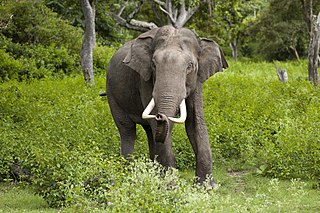 W
WThe Indian elephant is one of three extant recognised subspecies of the Asian elephant and native to mainland Asia.
 W
WThe Indian grey mongoose is a mongoose species native to the Indian subcontinent and West Asia. It is listed as Least Concern on the IUCN Red List. The grey mongoose inhabits open forests, scrublands and cultivated fields, often close to human habitation. It lives in burrows, hedgerows and thickets, among groves of trees, and takes shelter under rocks or bushes and even in drains. It is very bold and inquisitive but wary, seldom venturing far from cover. It climbs very well. Usually found singly or in pairs. It preys on rodents, snakes, birds’ eggs and hatchlings, lizards and variety of invertebrates. Along the Chambal River it occasionally feeds on gharial eggs. It breeds throughout the year.
 W
WThe kiang is the largest of the Asinus subgenus. It is native to the Tibetan Plateau, where it inhabits montane and alpine grasslands. Its current range is restricted to plains of the Tibetan plateau and Ladakh, India, and northern Nepal along the Tibetan border. Other common names for this species include Tibetan wild ass, khyang and gorkhar. Travellers' accounts of the kiang are one inspiration for the unicorn.
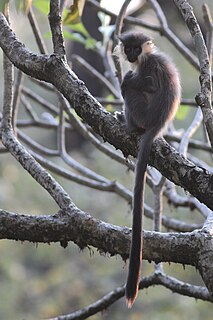 W
WThe capped langur is a species of primate in the family Cercopithecidae. It is found in Bangladesh, Bhutan, India, and Myanmar. Its natural habitat is subtropical or tropical dry forests. It is threatened by habitat loss. They are arboreal and gregarious by nature. A herd of capped langur consists of 2 to 14 langurs led by a brawny male langur. They are herbivorous, ingesting leaves, twigs, buds and fruits.
 W
WGee's golden langur, also known as simply the golden langur, is an Old World monkey found in a small region of western Assam, India and in the neighboring foothills of the Black Mountains of Bhutan. It is one of the most endangered primate species of India. Long considered sacred by many Himalayan people, the golden langur was first brought to the attention of the western world by the naturalist E. P. Gee in the 1950s. In a part of Bhutan, it has hybridised with the capped langur T. pileatus.
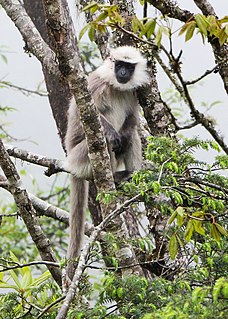 W
WThe Nepal gray langur is a gray langur endemic to the Himalayas in Nepal, far southwestern Tibet, northern India, northern Pakistan, Bhutan and possibly Afghanistan. It is found in forests at an elevation of 1,500 to 4,000 metres. Its easternmost limit in India is Buxa Tiger Reserve in northern West Bengal, at least up to the Rydak river.
 W
WThe Tarai gray langur is an Old World monkey, and was formerly considered a subspecies of the northern plains gray langur. The species is listed as Near Threatened, as there are probably not many more than 10,000 mature individuals, and it is experiencing a continuing decline.
 W
WThe leopard cat is a small wild cat native to continental South, Southeast, and East Asia. Since 2002 it has been listed as Least Concern on the IUCN Red List as it is widely distributed although threatened by habitat loss and hunting in parts of its range.
 W
WThe Indian leopard is a leopard subspecies widely distributed on the Indian subcontinent. The species Panthera pardus is listed as Vulnerable on the IUCN Red List because populations have declined following habitat loss and fragmentation, poaching for the illegal trade of skins and body parts, and persecution due to conflict situations.
 W
WThe snow leopard, also known as the ounce, is a large cat native to the mountain ranges of Central and South Asia. It is listed as Vulnerable on the IUCN Red List because the global population is estimated to number less than 10,000 mature individuals and is expected to decline about 10% by 2040. It is threatened by poaching and habitat destruction following infrastructural developments. It inhabits alpine and subalpine zones at elevations from 3,000 to 4,500 m, ranging from eastern Afghanistan, the Himalayas and the Tibetan Plateau, to southern Siberia, Mongolia, and western China. In the countries in the northern part of its range, it also lives at lower elevations.
 W
WThe spotted linsang is a linsang, a tree-dwelling carnivorous mammal, native to much of Southeast Asia. It is widely, though usually sparsely, recorded, and listed as Least Concern on the IUCN Red List.
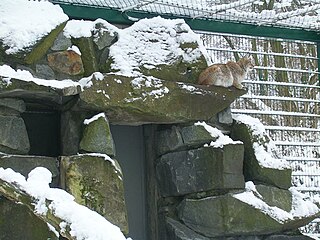 W
WThe Turkestan lynx is a subspecies of Eurasian lynx native to Central Asia. It is also known as Central Asian lynx, Tibetan lynx or Himalayan lynx. It is widespread from west in Central Asia, from South Asia to China and Mongolia. There are 27,000 mature individuals in China as of 2013. It is proposed for the Turkestan lynx to be listed as Vulnerable in Uzbekistan.
 W
WThe Assam macaque or Assamese macaque is a macaque of the Old World monkey family native to South and Southeast Asia. Since 2008, the species has been listed as "near threatened" by the IUCN, as it is experiencing significant declines due to hunting, habitat degradation, and fragmentation.
 W
WThe rhesus macaque is a species of Old World monkey. It is listed as least concern in the IUCN Red List of Threatened Species in view of its wide distribution, presumed large population, and its tolerance of a broad range of habitats. It is native to South, Central, and Southeast Asia and has the widest geographic range of all non-human primates, occupying a great diversity of altitudes and a great variety of habitats, from grasslands to arid and forested areas, but also close to human settlements.
 W
WThe marbled cat is a small wild cat native from the eastern Himalayas to Southeast Asia, where it inhabits forests up to 2,500 m (8,200 ft) altitude. As it is present in a large range, it has been listed as Near Threatened on the IUCN Red List since 2015.
 W
WMuntjacs, also known as barking deer or rib-faced deer are small deer of the genus Muntiacus native to south and southeast Asia. Muntjacs are thought to have begun appearing 15–35 million years ago, with remains found in Miocene deposits in France, Germany and Poland. Most species are listed as Least Concern or Data Deficient by the IUCN although others such as the black muntjac, Bornean yellow muntjac and giant muntjac are Vulnerable, Near Threatened and Critically Endangered respectively.
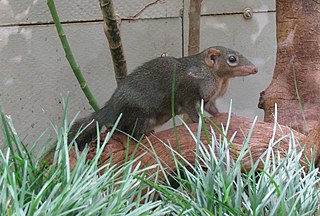 W
WThe northern treeshrew is a treeshrew species native to Southeast Asia.
 W
WThe Chinese pangolin is a pangolin native to the northern Indian subcontinent, northern parts of Southeast Asia and southern China. It has been listed as Critically Endangered on the IUCN Red List since 2014, as the wild population is estimated to have declined by more than 80% in three pangolin generations, equal to 21 years. It is threatened by poaching for the illegal wildlife trade.
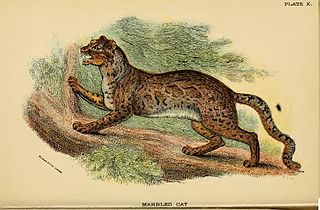 W
WPardofelis is a genus of the cat family Felidae. This genus is defined as including one species native to Southeast Asia: the marbled cat. Two other species, formerly classified to this genus, now belong to the genus Catopuma.
 W
WThe red panda is a mammal species native to the eastern Himalayas and southwestern China. It is listed as Endangered on the IUCN Red List because the wild population is estimated at fewer than 10,000 mature individuals and continues to decline due to habitat loss and fragmentation, poaching, and inbreeding depression. Despite its name, it is not closely related to the giant panda.
 W
WThe mainland serow is a serow species native to the Himalayas, Southeast Asia and China.
 W
WThe giant mole shrew is a species of red-toothed shrew native to the southeastern slopes of the Himalaya of Bhutan and India.
 W
WThe Siberian weasel or kolonok is a medium-sized weasel native to Asia, where it is widely distributed and inhabits various forest habitats and open areas. It is therefore listed as Least Concern on the IUCN Red List.
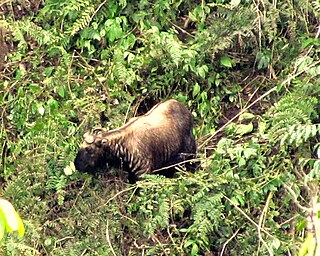 W
WThe Bhutan takin is a vulnerable subspecies of Takin native to Bhutan, North Eastern India, Western part of China, and Tibet. The main threats to the Bhutan Takin are hunting and habitat loss.
 W
WThe Bengal tiger is a tiger from a specific population of the Panthera tigris tigris subspecies that is native to the Indian subcontinent. It is threatened by poaching, loss, and fragmentation of habitat, and was estimated at comprising fewer than 2,500 wild individuals by 2011. None of the Tiger Conservation Landscapes within its range is considered large enough to support an effective population of more than 250 adult individuals. India's tiger population was estimated at 1,706–1,909 individuals in 2010. By 2018, the population had increased to an estimated 2,603–3,346 individuals. Around 300–500 tigers are estimated in Bangladesh, 220–274 tigers in Nepal and 103 tigers in Bhutan.
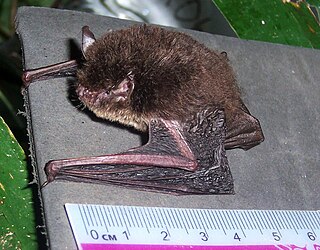 W
WThe wall-roosting mouse-eared bat, or Nepalese whiskered myotis is a species of vesper bat whose type locality is Nepal.
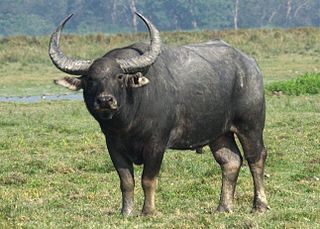 W
WThe wild water buffalo, also called Asian buffalo, Asiatic buffalo and wild Asian buffalo, is a large bovine native to the Indian subcontinent and Southeast Asia. It has been listed as Endangered in the IUCN Red List since 1986, as the remaining population totals less than 4,000. A population decline of at least 50% over the last three generations is projected to continue. The global population has been estimated at 3,400 individuals, of which 3,100 (91%) live in India, mostly in Assam. The wild water buffalo is the probable ancestor of the domestic water buffalo.